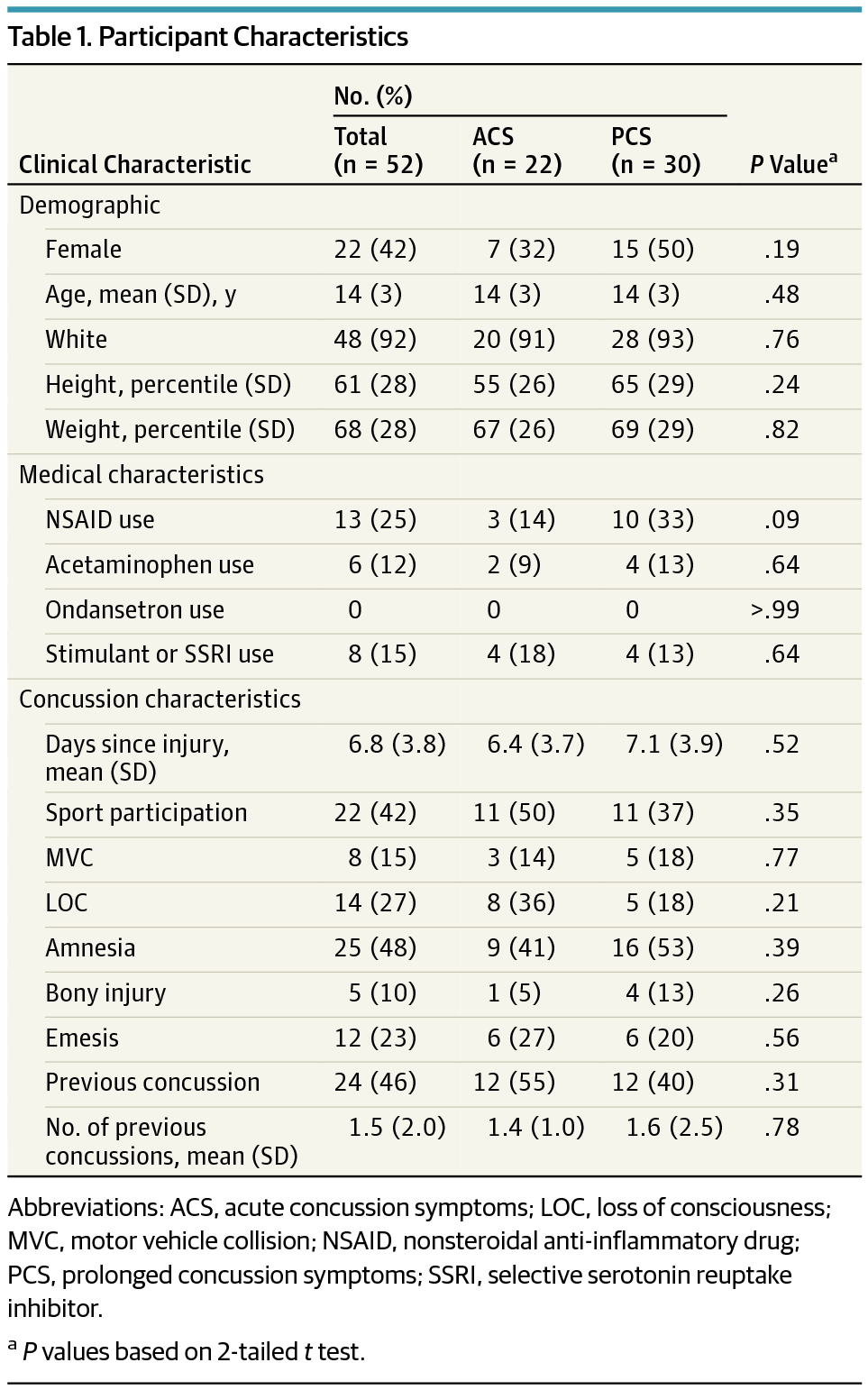当前位置:
X-MOL 学术
›
JAMA Pediatr.
›
论文详情
Our official English website, www.x-mol.net, welcomes your
feedback! (Note: you will need to create a separate account there.)
Association of Salivary MicroRNA Changes With Prolonged Concussion Symptoms
JAMA Pediatrics ( IF 24.7 ) Pub Date : 2018-01-01 , DOI: 10.1001/jamapediatrics.2017.3884 Jeremiah J. Johnson 1 , Andrea C. Loeffert 1 , Jennifer Stokes 1 , Robert P. Olympia 1, 2 , Harry Bramley 1 , Steven D. Hicks 1
JAMA Pediatrics ( IF 24.7 ) Pub Date : 2018-01-01 , DOI: 10.1001/jamapediatrics.2017.3884 Jeremiah J. Johnson 1 , Andrea C. Loeffert 1 , Jennifer Stokes 1 , Robert P. Olympia 1, 2 , Harry Bramley 1 , Steven D. Hicks 1
Affiliation

|
Importance Approximately one-third of children who experience a concussion develop prolonged concussion symptoms. To our knowledge, there are currently no objective or easily administered tests for predicting prolonged concussion symptoms. Several studies have identified alterations in epigenetic molecules known as microRNAs (miRNAs) following traumatic brain injury. No studies have examined whether miRNA expression can detect prolonged concussion symptoms. Objective To evaluate the efficacy of salivary miRNAs for identifying children with concussion who are at risk for prolonged symptoms. Design, Setting, and Participants This prospective cohort study at the Penn State Medical Center observed 52 patients aged 7 to 21 years presenting for evaluation of concussion within 14 days of initial head injury, with follow-up at 4 and 8 weeks. Exposures All patients had a clinical diagnosis of concussion. Main Outcomes and Measures Salivary miRNA expression was measured at the time of initial clinical presentation in all patients. Patients with a Sport Concussion Assessment Tool (SCAT3) symptom score of 5 or greater on self-report or parent report 4 weeks after injury were designated as having prolonged symptoms. Results Of the 52 included participants, 22 (42%) were female, and the mean (SD) age was 14 (3) years. Participants were split into the prolonged symptom group (n = 30) and acute symptom group (n = 22). Concentrations of 15 salivary miRNAs spatially differentiated prolonged and acute symptom groups on partial least squares discriminant analysis and demonstrated functional relationships with neuronal regulatory pathways. Levels of 5 miRNAs (miR-320c-1, miR-133a-5p, miR-769-5p, let-7a-3p, and miR-1307-3p) accurately identified patients with prolonged symptoms on logistic regression (area under the curve, 0.856; 95% CI, 0.822-0.890). This accuracy exceeded accuracy of symptom burden on child (area under the curve, 0.649; 95% CI, 0.388-0.887) or parent (area under the curve, 0.562; 95% CI, 0.219-0.734) SCAT3 score. Levels of 3 miRNAs were associated with specific symptoms 4 weeks after injury; miR-320c-1 was associated with memory difficulty (R, 0.55; false detection rate, 0.02), miR-629 was associated with headaches (R, 0.47; false detection rate, 0.04), and let-7b-5p was associated with fatigue (R, 0.45; false detection rate, 0.04). Conclusions and Relevance Salivary miRNA levels may identify the duration and character of concussion symptoms. This could reduce parental anxiety and improve care by providing a tool for concussion management. Further validation of this approach is needed.
中文翻译:

唾液微RNA变化与长期脑震荡症状的关联
重要性 大约三分之一经历过脑震荡的儿童会出现长时间的脑震荡症状。据我们所知,目前没有客观或易于管理的测试来预测长期脑震荡症状。几项研究已经确定了外伤性脑损伤后被称为 microRNA (miRNA) 的表观遗传分子的改变。没有研究检查 miRNA 表达是否可以检测到长时间的脑震荡症状。目的 评估唾液 miRNAs 在识别有长期症状风险的脑震荡儿童中的有效性。设计、设置和参与者 这项在宾夕法尼亚州立医学中心进行的前瞻性队列研究观察了 52 名年龄在 7 至 21 岁之间的患者,他们在最初头部受伤后的 14 天内接受了脑震荡评估,并在第 4 周和第 8 周进行了随访。暴露 所有患者都有脑震荡的临床诊断。主要结果和测量在所有患者的初始临床表现时测量唾液miRNA表达。伤后 4 周,运动脑震荡评估工具 (SCAT3) 症状评分为 5 分或更高的患者被指定为有长期症状。结果 在纳入的 52 名参与者中,22 名 (42%) 为女性,平均 (SD) 年龄为 14 (3) 岁。参与者分为长期症状组(n = 30)和急性症状组(n = 22)。在偏最小二乘判别分析中,15 种唾液 miRNA 的浓度在空间上区分了长期和急性症状组,并证明了与神经元调节通路的功能关系。5 种 miRNA(miR-320c-1、miR-133a-5p、miR-769-5p、let-7a-3p 和 miR-1307-3p) 在逻辑回归中准确识别出症状延长的患者(曲线下面积,0.856;95% CI,0.822-0.890)。该准确性超过了儿童(曲线下面积,0.649;95% CI,0.388-0.887)或父母(曲线下面积,0.562;95% CI,0.219-0.734)SCAT3 评分的症状负担准确性。损伤后 4 周,3 种 miRNA 的水平与特定症状相关;miR-320c-1 与记忆困难有关(R,0.55;误检率,0.02),miR-629 与头痛有关(R,0.47;误检率,0.04),let-7b-5p 与头痛有关疲劳(R,0.45;误检率,0.04)。结论和相关性唾液miRNA水平可以识别脑震荡症状的持续时间和特征。这可以通过提供脑震荡管理工具来减少父母的焦虑并改善护理。需要进一步验证这种方法。
更新日期:2018-01-01
中文翻译:

唾液微RNA变化与长期脑震荡症状的关联
重要性 大约三分之一经历过脑震荡的儿童会出现长时间的脑震荡症状。据我们所知,目前没有客观或易于管理的测试来预测长期脑震荡症状。几项研究已经确定了外伤性脑损伤后被称为 microRNA (miRNA) 的表观遗传分子的改变。没有研究检查 miRNA 表达是否可以检测到长时间的脑震荡症状。目的 评估唾液 miRNAs 在识别有长期症状风险的脑震荡儿童中的有效性。设计、设置和参与者 这项在宾夕法尼亚州立医学中心进行的前瞻性队列研究观察了 52 名年龄在 7 至 21 岁之间的患者,他们在最初头部受伤后的 14 天内接受了脑震荡评估,并在第 4 周和第 8 周进行了随访。暴露 所有患者都有脑震荡的临床诊断。主要结果和测量在所有患者的初始临床表现时测量唾液miRNA表达。伤后 4 周,运动脑震荡评估工具 (SCAT3) 症状评分为 5 分或更高的患者被指定为有长期症状。结果 在纳入的 52 名参与者中,22 名 (42%) 为女性,平均 (SD) 年龄为 14 (3) 岁。参与者分为长期症状组(n = 30)和急性症状组(n = 22)。在偏最小二乘判别分析中,15 种唾液 miRNA 的浓度在空间上区分了长期和急性症状组,并证明了与神经元调节通路的功能关系。5 种 miRNA(miR-320c-1、miR-133a-5p、miR-769-5p、let-7a-3p 和 miR-1307-3p) 在逻辑回归中准确识别出症状延长的患者(曲线下面积,0.856;95% CI,0.822-0.890)。该准确性超过了儿童(曲线下面积,0.649;95% CI,0.388-0.887)或父母(曲线下面积,0.562;95% CI,0.219-0.734)SCAT3 评分的症状负担准确性。损伤后 4 周,3 种 miRNA 的水平与特定症状相关;miR-320c-1 与记忆困难有关(R,0.55;误检率,0.02),miR-629 与头痛有关(R,0.47;误检率,0.04),let-7b-5p 与头痛有关疲劳(R,0.45;误检率,0.04)。结论和相关性唾液miRNA水平可以识别脑震荡症状的持续时间和特征。这可以通过提供脑震荡管理工具来减少父母的焦虑并改善护理。需要进一步验证这种方法。











































 京公网安备 11010802027423号
京公网安备 11010802027423号